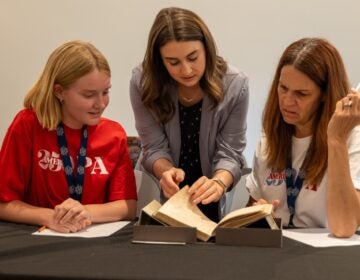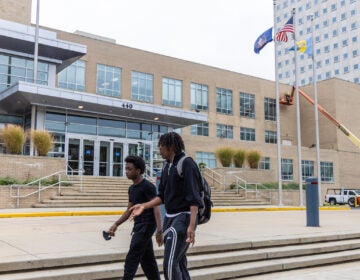Philly parents weigh prospect of turning schools over to charter operators
ListenRenaissance charters are required to serve all kids from the existing neighborhood. They’re run by charter organizations that employ non-union staff and have more autonomy in how they spend money.
Tara Magras has close ties with Edward T. Steel Elementary in Nicetown.
She lives a block from the school, volunteers there almost everyday, entrusts her three young children to the faculty and staff.
Although she concedes that the school’s “test scores are low,” the prospect of Steel becoming a charter school makes her uneasy.
“I don’t have anything against charters,” she said in an interview outside of the school. “It’s just that I like the teachers here.”
Magras’ reaction comes on the heels of the Philadelphia School District’s announcement last week that it would like to add Steel, as well as Luis Muñoz-Marín Elementary in Fairhill, to its portfolio of “Renaissance” charter schools.
Right now, both schools are neighborhood preK-8 elementary schools that the district considers among its lower performers.
As renaissance charters, the schools would continue to be required to serve all kids from the existing neighborhood catchment boundaries, but would be run by charter organizations that employ non-union staff and more autonomy in how they compose their budgets – creating greater flexibility in how the schools spend money.
The district has matched two of the highest-performing turnaround specialists in the city to the schools. Steel would become part of Mastery’s network; Muñoz-Marin would go to ASPIRA.
Since 2010, the district has turned 20 schools over to charter organizations through the renaissance initiative.
But this year, there’s a new twist to the Renaissance conversion process: If parents don’t like the plan, they can vote to keep the schools within the district.
Magras – who, in the past, has tried and failed to enroll her children at other charters through their lottery processes – wouldn’t say how she would cast her ballot.
If parents at Steel vote to allow Mastery to manage the school, all staff would have to reapply for their jobs – a prospect that troubles Magras.
“You’re waiting to get to Mrs. Kelly’s class because everybody’s talking about ‘Mrs. Kelly,'” but then, when Mastery comes in, she explained, “It’s time to go to Mrs. Kelly’s class, and then Mrs. Kelly’s not here no more. What’cha gonna do?”
“I’m not going to knock the Mastery charter school,” she said, “but, I think they just need to leave [Steel] as it is, and work to make it better.”
Another Steel parent, Dolores Waters, chimed in. No need to charterize the school, she says, just provide more funding.
“I’m a product of Steel…my mother’s a product of Steel….Steel school’s been in my family since forever,” she said. “So we just kicking all this away because Mastery want to come in, instead of just giving money to help. It’s not fair to these kids.”
Waters has a daughter in Steel’s 6th grade. Her son graduated last year and now attends Parkway Center City, one of the district’s magnet high schools.
“And he’s doing excellent,” she said, “because he’s a product of Steel.”
Some Steel parents, though, plan to embrace Mastery’s potential presence wholeheartedly.
“I think it’s a good thing,” said kindergarten parent Al Greer. “It’ll get a better education for the children.”
“I know charter schools,” he said. “My oldest son, he was in a charter school and he graduated and is in college.” (The oldest son attended one of Mastery’s lottery-based charters).
As he spoke, Greer held the hand of his kindergarten son, Semaj. “For his future, I’m voting, ‘yes,'” he said.
The pitch
Over the next few weeks, parents at both Steel and Muñoz-Marín will hear pitches from both the charter operators and the existing school leadership staffs. Each side will make the case that they can best transform academic performance and school culture.
Mastery already manages seven renaissance charters – six elementary schools, and one high school, Simon Gratz, which Steel feeds into.
All of Mastery’s Renaissance charter elementaries have seen double-digit percentage gains in reading and math test scores since the changeover. The District’s Office of Accountability and Assessment concluded in a recent report that all of Mastery’s Renaissance schools are on track to exceed 60 percent proficiency in math by 2016. Five of the seven, the report says, are on track to meet this benchmark in reading.
ASPIRA already manages two Renaissance charters, Stetson middle school (5-8) and Olney High.
Since turnaround, Stetson has seen reading scores increase by 7.79 percent and math by 24.55 percent. In the district’s report, Olney was on track for 60 percent proficiency in both subjects; Stetson was on track in math.
In a telephone interview, Mastery CEO Scott Gordon emphasized that his organization has a proven track record of making gains by serving exactly the same students as the prior district management, with a nearly identical amount of public money. Ninety-two cents of every dollar Mastery spends, he says, goes towards schools.
“Parents and students will get a bigger bang for the buck,” said Gordon. “We spend our money on schools, on teachers, on students. So students will have not only great reading and great math and science, they will have art, they will have music, they will have Spanish. They will have gym. They’ll have a well-rounded education.”
Gordon further stressed that the school will admit all students living within the catchment, and that anyone who’s in the school currently, no matter where they live, will be “guaranteed admission.”
Orlando Rendon, ASPIRA’s COO, said his organization is uniquely suited to serve Muñoz-Marín’s 83 percent Latino population. “This is our community,” he said.
As far as financial resources, although Rendon said that ASPIRA would work with “the exact same allocation as the district,” he went on to explain that “there are additional funding sources that are available to support schools that are turnaround efforts such as ours, but that is something that we need to apply for and hopefully we get awarded…school improvement grants, Philadelphia School Partnership grants, things of that nature.”
Rendon said ASPIRA’s turnaround model includes buying new furniture, installing security cameras, updating technology, and increasing professional development time for teachers.
Both Mastery and ASPIRA claim that their staff and teacher compensation packages are comparable with what the district offers. Both, though, employ their staff at will, i.e. no tenure protection, and expect employees to work a longer contracted set of hours.
Steel elementary principal Mary Bonner did not return a request for comment. Ximena Carreno, principal at Muñoz-Marín, said she was instructed by the school district not to speak to the media.
As seen in the graph below, according to most recent state data, Muñoz-Marín (preK-8) has a slightly higher proficiency rate in reading than Stetson elementary (5-8), which ASPIRA assumed control of in 2010.
Muñoz-Marín’s math scores are much lower than Stetson’s.
Campaigning in Nicetown
Future Steel parent Charisma Presley, co-founder of the Concerned Neighbors of Nicetown, worries that her community has not been getting “both sides of the story.”
She says Mastery has been in the neighborhood “campaigning for months” – well before the district’s intention was made known to the public. This gives Mastery an advantage over the existing Steel leadership, she says.
“The parents and the community haven’t been informed about both sides,” said Presley in a telephone interview. “All they’re hearing is one side, and I think that’s unfair….some people are just like: ‘Oh, this is what Mastery is going to do.'”
Although Presley lives in the Steel catchment and is one of Nicetown’s grassroots leaders, she will not be allowed to cast a vote in the election because her two young children are not yet school aged.
“It’s so frustrating,” she said. “I’m just thinking about how many emergency contacts I am for people in the community…and I can’t say anything.”
Mastery’s Gordon disagreed with Presley’s “campaigning” assessment, saying the school district notified Mastery of its intent only the day before the Renaissance announcement was made public.
“We’ve not been campaigning,” he said, while adding that Mastery commonly does outreach in many communities across the city.
“Hopefully one of our strengths is that we are connected to our communities,” he said, “and we talk to a lot of parents who are frustrated that they can’t get into a Mastery school.”
Gordon also pointed out that Mastery doesn’t have the addresses of students currently attending Steel; the existing leadership does.
The school district has forbade all parties of campaigning to students about the possible conversion.
If Steel becomes part of Mastery’s network, it would be the third Mastery renaissance charter feeding into its renaissance at Simon Gratz high school – joining Grover Cleveland and George Clymer elementaries.
Of the remaining three schools that feed into Gratz, two are district-run – Mary Bethune and Tanner G. Duckrey –and the other is another renaissance charter – Young Scholars Kenderton.
“This has been a neighborhood that has not had the high-quality schools that they deserve,” said Gordon.
Stranded costs
If parents approve the plan, the conversion will have economic repercussions.
When the district converts a school to a Renaissance charter, it claims it incurs stranded costs at a rate of $4,000 per student.
To be clear, this isn’t money that will pour additional resources into Steel or Marin, but instead, fund the overhead costs associated with the decline in district enrollment.
“With Renaissance charter conversions, we can reduce our direct costs in school budgets, such as teacher/principal salaries and building maintenance,” said Paul Kihn, the district’s deputy superintendent. “However, we cannot reduce the other kinds of indirect costs (‘stranded costs’) that we currently spend on students in that school, such as central administration services and personnel, facilities and utilities expenses, and special education and ESOL services.”
Essentially, the costs add up based on district employees who are responsible for providing services to multiple buildings. For instance, a speech therapist who currently works at a host of different schools including Steel, would still receive the same salary even if Steel and its students leave the district’s purview.
With a combined enrollment of 1,286 students, if Steel and Muñoz-Marín both become Renaissance charters the district would incur stranded costs to the tune of about $5.1 million dollars. (The school district said it could not yet confirm this math.) As former SRC commissioner Joe Dworetzky put it: “that money is just lost to education.”
The district declined to provide a detailed accounting of how these stranded costs reach $4,000 per student.
“It does not sound right, and it does not make sense to me,” said Mastery’s Gordon. “I can imagine where there would be some small differences. Different organizations have different overhead or administrative centralized costs, but…we are taking all the students; we’re taking all the costs for the building; any ancillary costs that would be involved in running that school [would] no longer [be] an expense to the school district.”
In 2013, the district quoted the stranded costs of doing Renaissance charter conversions at $1000 to $1500 per pupil.
The 2012 Boston Consulting Group report quoted the stranded cost at $800 to $1000 per pupil.
Investment strategy
The district is currently facing a $440 million budget gap for next school year. It needs $220 million of that just to be able to provide the same level of resources and services as this year.
“Apparently the severity of the district’s fiscal crisis depends on which schools they want to fund,” wrote Jerry Jordan, president of the Philadelphia Federation of Teachers in an official statement. “They seem to have no problem adding to next school year’s projected $440 million deficit…as long as they convert to charter schools. That’s money that could go a long way toward providing children with nurses, counselors, librarians, paper, books, computers, music and art in traditional public schools.”
Superintendent William Hite thinks of the stranded costs as a wise “investment.”
“This is looking at it from the perspective of: ‘where should we make investments…that will move student achievement as fast as we can possibly move it,’ said Hite. “That’s the conversation that we’re having internally.”
If great transformation comes as a result of new management, Hite and his team say the price will be well worth it.
ASPIRA has been criticized for its financial practices. The City Paper obtained an audit last year showing that ASPIRA was moving money meant for the charters to its parent organization, which the District has no power to audit.
In a telephone interview with reporters last week, Kihn said that the District “has no reason to believe … there has been any financial impropriety or any reason not to partner with them. We are currently looking into this and if anything comes to light, we will take necessary action.”
A coalition of teachers hoping to unionize at Olney have also accused ASPIRA of unfair labor practices, which ASPIRA’s board chair has denied.
The vote
Parents at Steel will hear presentations from Mastery and current school leadership on April 23 and 29.
Parents at Muñoz-Marín will hear from ASPIRA and current school leadership on April 15 and 28.
For each school, the district will hold two votes – one for parents regularly participating in the school advisory council, the other a general election for all parents.
If the results of these two tallies are at odds, the district will make its own recommendation to the School Reform Commission, but said it could not yet explain how it would choose between the two results.
Parent-wide voting will take place at the respective schools on May 1 from 8 a.m. to 7 p.m.
In the chart below, you can see the academic performance and demographic data of Edward T. Steel and Luis Muñoz-Marín Elementaries.
Also included is ASPIRA’s existing renaissance charter elementary, John Stetson, and Mastery’s two other nearby Renaissance charter elementaries (Cleveland and Clymer) that feed into Simon Gratz High (which Mastery also manages through the renaissance initiative).
Figures have been rounded to the nearest whole number.
|
*District schools and charter schools use different methods to calculate % economically disadvantaged. Hard to compare apples to apples here.
WHYY is your source for fact-based, in-depth journalism and information. As a nonprofit organization, we rely on financial support from readers like you. Please give today.








